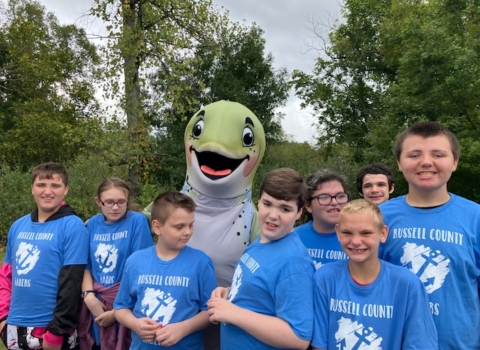By Jan Peterson, for the U.S. Fish and Wildlife Service’s Pacific Region
Rare habitat and animal species – including humans – in Oregon are about to enjoy a massive benefit thanks to almost $700,000 provided to the U.S. Fish and Wildlife Service through the Bipartisan Infrastructure Law Bipartisan Infrastructure Law
The Bipartisan Infrastructure Law (BIL) is a once-in-a-generation investment in the nation’s infrastructure and economic competitiveness. We were directly appropriated $455 million over five years in BIL funds for programs related to the President’s America the Beautiful initiative.
Learn more about Bipartisan Infrastructure Law (BIL). Damien Miller, project leader at the Willamette Valley National Wildlife Refuge Complex in Corvallis, says this funding will be used to reduce fuels within forested areas between mountains and cities so prescribed burns can be used to protect declining oak savanna habitat and nearby homes from raging wildfires in the future.
The fuels-reduction program is a crucial step in restoring the savanna and returning to the practice of regular prescribed burning, which helps maintain this key habitat type. The Willamette Valley was once mostly oak and prairie that was maintained through Native Americans’ regular burning. Since that practice stopped, most habitats have been converted to agriculture or been developed, and the remaining oak savannas have been heavily infiltrated by other trees and shrubs. This has created dense forests with a buildup of hazardous fuels just ripe for ignition.
“When historic burning stopped, the firs and woody undergrowth proliferated,” Miller explains. “The firs shade out the oak over time and will eventually kill them. Dense forests are also more susceptible to wildfire. We are going to use BIL funding to remove dense non-native woody undergrowth in some areas and dense fir trees in other areas to release suppressed oak trees and restore oak woodlands and savannas. That habitat type is extremely rare in the valley anymore because a lot of it has been developed or taken over by fir. The open prairie/oak type of habitat is home to many of the declining species in the valley.
“By pulling those fir trees out of there now, and removing the dense underbrush that serve as ladder fuels, it’s going to be a more open habitat type that benefits several key species while also allowing us to conduct controlled burns to safely maintain it,” Miller says.
Jarod Jebousek – a fish and wildlife biologist with the Service’s Partners for Fish and Wildlife Program – has been working with the Confederated Tribes of Siletz Indians, McKenzie River Trust, Cerro Gordo Land Conservancy and Lane Countyto reduce hazardous fuels on three properties.
“I’d like to get started this summer and work on these properties for the next three years or so, which will ultimately culminate in some prescribed burning on each of these properties,” Jebousek says.
The properties Jebousek and his partners are working lie in strategically important areas.
“The areas where my projects are located are adjacent to populated areas,” he says. “They have houses all around, and cities and towns just beyond that. Reducing the threat of wildfire is really important and is becoming much more so in the coming years.”
But it will take years of hard work to get the properties to the point where anyone can even consider planning a burn.
“We can’t go out and just start burning the way it is,” he says. “It either wouldn’t burn or would be an inferno. The heavy lift at the beginning is clearing the hazardous fuels so we can create safe conditions for prescribed burns. It’s going to be forest thinning and removal of woody undergrowth to get a more herbaceous understory of grasses and native wildflowers.”
He says this work and the controlled burns that follow are crucial to maintaining a healthy oak savanna habitat and protecting developed areas.
“In these locations, there are a lot of ancient oak trees that are holding on in overstocked conditions. If there were a fire, it would probably kill the oak trees. So the hope is, if we get this opened up with just herbaceous undergrowth for the most part, if there were ever a wildfire, it would keep the flames from crawling up to the crowns. Hopefully, the fire would be a safe, cleansing one rather than catastrophic,” Jebousek says.
The restoration and regular burns would not only protect humans but ensure a healthy habitat for animals that need more open conditions and large, mature oaks. They include the acorn woodpecker, Western bluebird, the white-breasted nuthatch and more. “It’s also really important for native plant diversity,” Jebousek says. “There are a lot of plants that are important for pollinators as well as being historic foods that Native Americans would have used.”
Jebousek says the project would have been impossible without the BIL funding: “This has greatly increased the Service’s capacity to come to the table and work with our partners on these efforts.”
The Bipartisan Infrastructure Law is a once-in-a-generation investment that helps local, state and Tribal communities tackle the climate crisis while creating jobs, advancing environmental justice and boosting local economies. By funding efforts to address intensifying drought, wildfires, flooding and legacy pollution, the law is the largest investment in the resilience of physical and natural systems in American history. Together we will build back better ecosystems and protect wildlife and wild spaces for the next generation.






